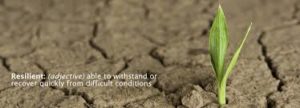Building Resiliency with Hypnosis and Mindfulness
 “Stressed?” Of course. We are all stressed. We are carving out an identity in academia, developing our research focus, writing grants, papers, and talks, all while attempting to have some “balance” in our lives. In fact, it would probably be a little concerning if you were not stressed.
“Stressed?” Of course. We are all stressed. We are carving out an identity in academia, developing our research focus, writing grants, papers, and talks, all while attempting to have some “balance” in our lives. In fact, it would probably be a little concerning if you were not stressed.
The war stories of mentors and advice from those intimately familiar with this career stage confirm we will adapt. We habituate. We become intimately familiar and comfortable in the fields we are in through practice and consistent work. As expectations become more familiar and expertise develops, we settle in.
But back to now: Attending to our stress levels and taking care of ourselves is extremely important to make it through this career stage, to adapt to increasing demands, and to build resilience.
Our “stuff” will surface during times of heightened tension, such as a transitional period in a career. It can be helpful to have tools to manage stress that can reduce anxiety, improve sleep, and boost energy levels. Once learned, they can be applied to myriad situations. If you practice them regularly, their effects extend and deepen over time.
As a clinical psychologist, I work closely with stress, anxiety, sadness, illness, life transitions…you name it. I hope you’ll consider two tools that I use often in practice and that can drastically change how people manage stress. That’s the key – the stress doesn’t go away. How we handle the stress changes – from “reacting” to “responding.”
Tool #1: Clinical Hypnosis
Yes. Hypnosis. In practice, clinical hypnosis is nothing like what you’ve seen on TV, at halftime shows of basketball games, or in Office Space (anyone remember that?). That’s “stage” hypnosis. So let’s separate fact from myth.
To understand hypnosis imagine the last time you felt deeply relaxed. I mean, so relaxed that you could just comfortably drift off to sleep wherever you were. That’s what hypnosis feels like – the state your body is in right before sleep: Heavy, comfortable. Aware of what is happening around you but also absorbed in how good you feel. During hypnosis, a practitioner will “guide” you into deep relaxation and provide you with suggestions for alterations in perception, thoughts, emotions, and behavior. Ultimately, the goal is for you to practice and then learn how to do self-hypnosis, practicing on your own.
Hypnosis can be helpful with performance anxiety, pain, headaches, chronic illnesses, sleep, and compulsions such as overeating, smoking, or nail biting. It can also enhance situational performance in athletics, speaking, acting, and playing music. Hypnosis is a skill you learn to apply whenever you are stressed or feeling tension. You can teach your body to become calm very quickly. It’s transforming.
Myths about hypnosis include: 1) you are not in control and 2) all you need is a good imagination and cooperation to be hypnotized. I can promise you that neither is true. You are in control the whole time. Your eyes are closed during the practice but they can open if you need them to. Hypnosis can be done with your eyes open riding a recumbent bike. Or driving. Or shooting free-throws.
Ability to imagine things vividly or cooperate with the practitioner is unrelated to hypnotic responding. How you respond to hypnosis depends on your hypnotizability, which can range from low to high. It is not related to personality or intelligence, and cannot be “learned.” Hypnotizability is a heritable trait that is stable over time. Although just about anyone can benefit from hypnosis, those who are more highly responsive to the intervention benefit more.
Tool #2: Mindfulness and Meditation

Mindfulness and meditation are a practice of “present-moment awareness.” To be mindful is to pay attention to the present moment, without judgment, just noticing what’s happening. This practice harnesses your ability to attend to internal and external experiences without freaking out.
For example, noticing that you may be feeling anxious before a talk, you might say to yourself, “Oh no! This is only going to get worse.” What happens next? Beads of sweat, racing heart, and you’re losing your focus. To be mindful in that situation would involve recognizing the physical sensations occurring in your body, noticing your emotional response, where it is coming from, and then asking yourself the question, “What do I need to do to help this?” Mindfulness teaches you to problem solve through difficulty as opposed to lighting up your insula.
Mindfulness training typically includes focused attention to breathing, body sensations, and mindful movement. This can be done through both formal and informal practices. A formal practice might involve a 2-5 minute meditation focusing on the breath. An informal practice may be paying attention to the experience of walking as you go from one building to another during the day.
After eight weeks of mindfulness and/or meditation practice, our brains and immune function change. Our attention and focus improve, and happiness increases. Have you ever heard about the “happiest” person in the world? According to a long series of neuroimaging studies, it’s a Tibetan Buddhist monk named Matthieu Ricard. He meditates for 15 minutes a day. I would consider that something to work up to. My goal is 5-10 minutes a day four days per week.
So, how do you learn these tools?
 My recommendation is to learn these tools face-to-face with another individual. Mindfulness and hypnosis can both be learned in individual and group settings. Mindfulness can also be learned through online and e-format platforms. In any psychotherapy community there are wonderful practitioners that accept health insurance who are trained in mindfulness, hypnosis, mind-body practices, and other things I did not mention in this post. Two websites to visit are www.psychologytoday.com or your insurance carrier’s website, where you can browse practitioners by insurance, location, and specialty.
My recommendation is to learn these tools face-to-face with another individual. Mindfulness and hypnosis can both be learned in individual and group settings. Mindfulness can also be learned through online and e-format platforms. In any psychotherapy community there are wonderful practitioners that accept health insurance who are trained in mindfulness, hypnosis, mind-body practices, and other things I did not mention in this post. Two websites to visit are www.psychologytoday.com or your insurance carrier’s website, where you can browse practitioners by insurance, location, and specialty.
The UMass Center for Mindfulness pioneered the original Mindfulness-Based Stress Reduction (MBSR) program that is now used all over the country. If you visit their website, you can locate MBSR teachers and programs near you, and also browse their online learning options. You can also simply research “MBSR classes” in your community and will likely find multiple avenues to choose from.
Lastly, consider mindfulness apps. Reputable options include InsightTimer, Headspace, and Stop/Breathe/Calm. Apps provide thousands of meditations to choose from and can be handy if you need a break in the middle of the day.
 With practice, learning mindfulness, hypnosis, and other tools to enhance our stress regulation ability now will pay dividends down the road in both career and life outside of work. These tools can both provide you with a larger quiver to hold more arrows, and also improve your mood, focus, and sleep at the same time.
With practice, learning mindfulness, hypnosis, and other tools to enhance our stress regulation ability now will pay dividends down the road in both career and life outside of work. These tools can both provide you with a larger quiver to hold more arrows, and also improve your mood, focus, and sleep at the same time.
More Resources
Creating a Clearing in the Woods
Just Breathe: Mindfulness Apps in a Pressured Time
Finding Your Science Flow: Yoga Lessons to Increase Productivity





0 Comments